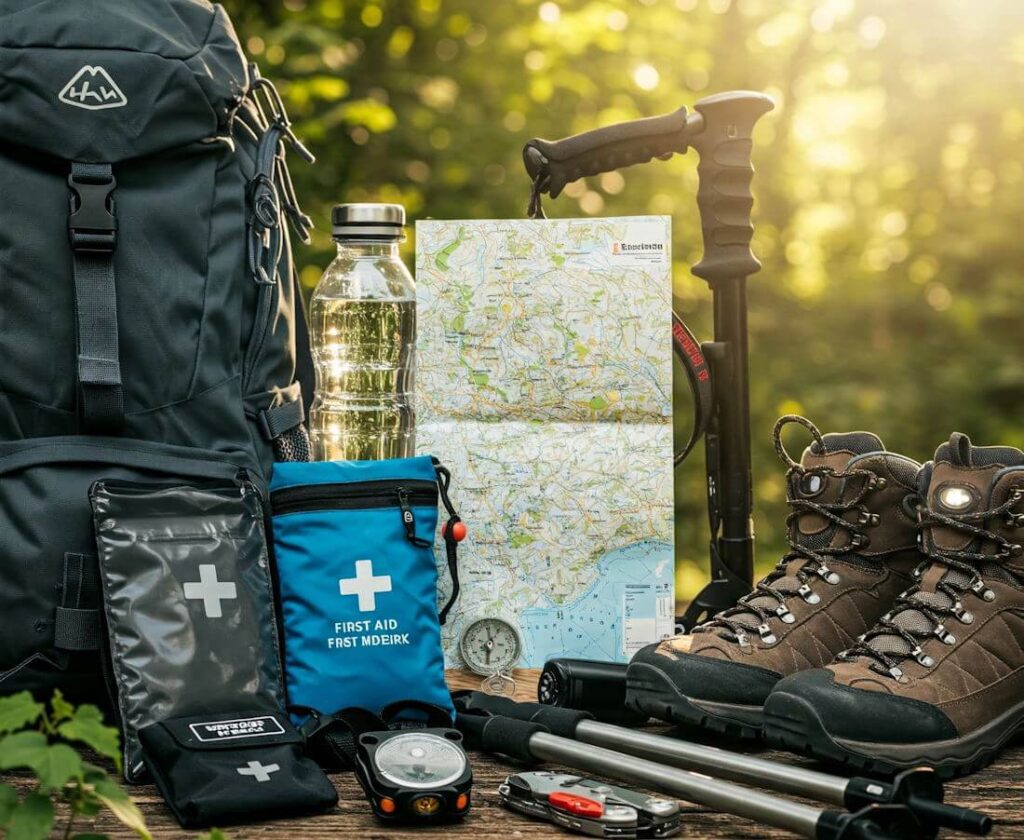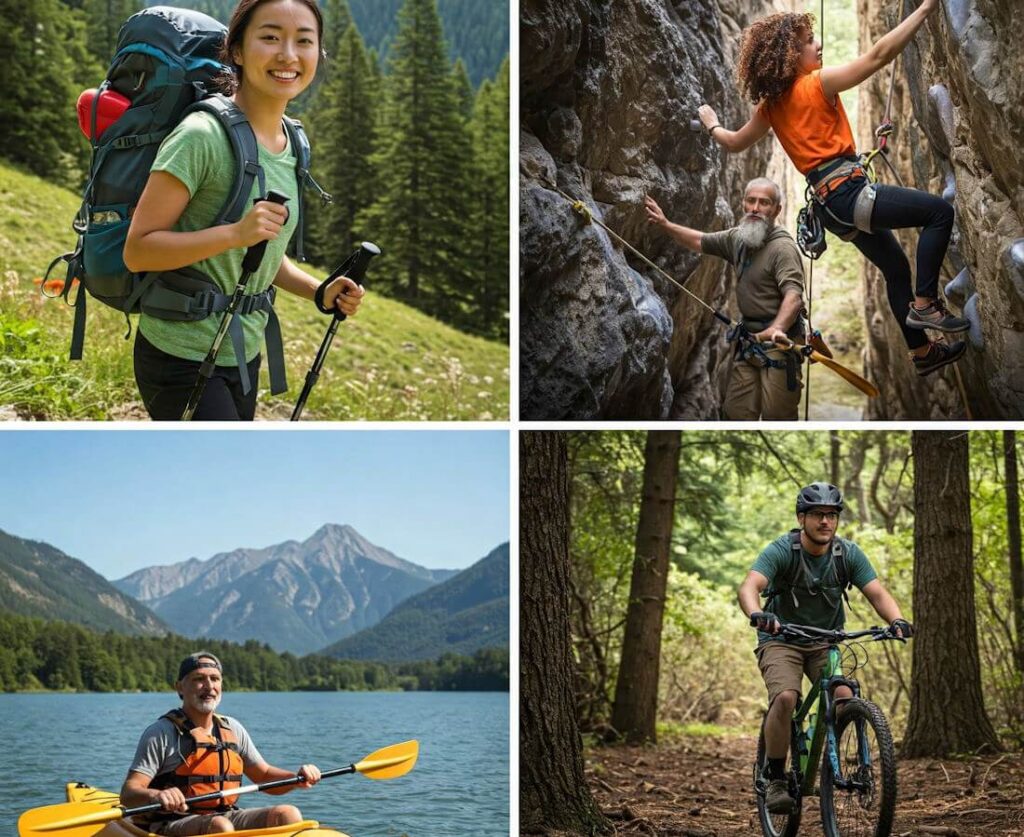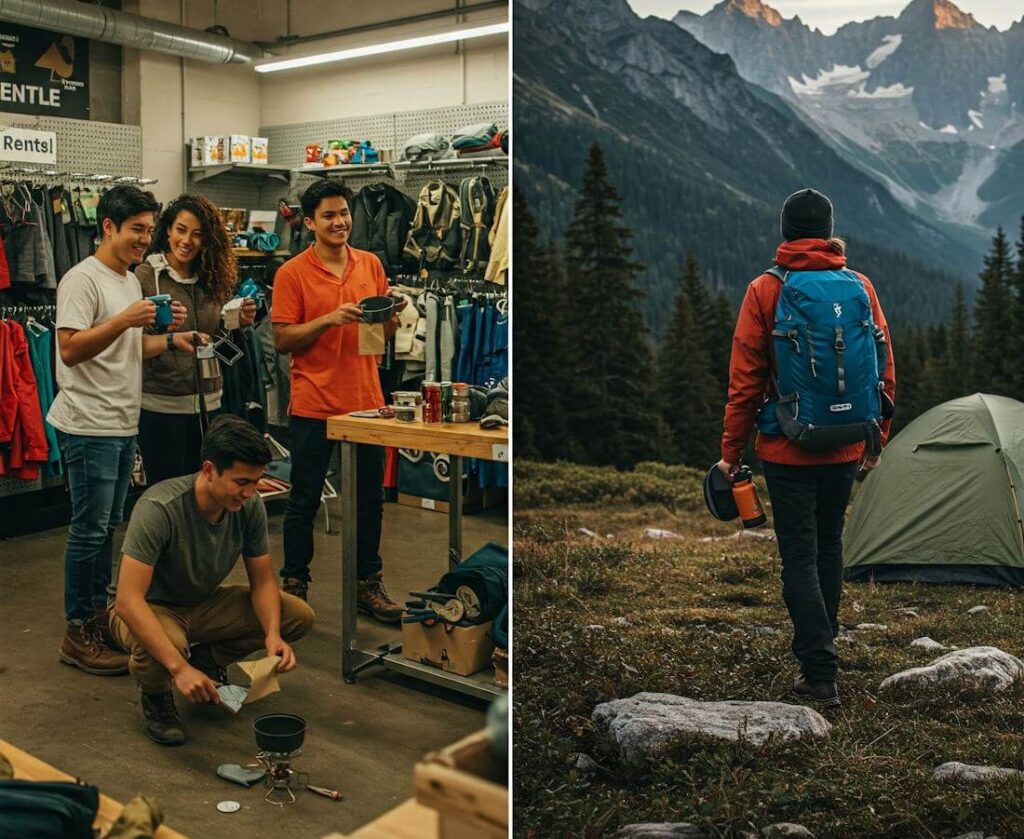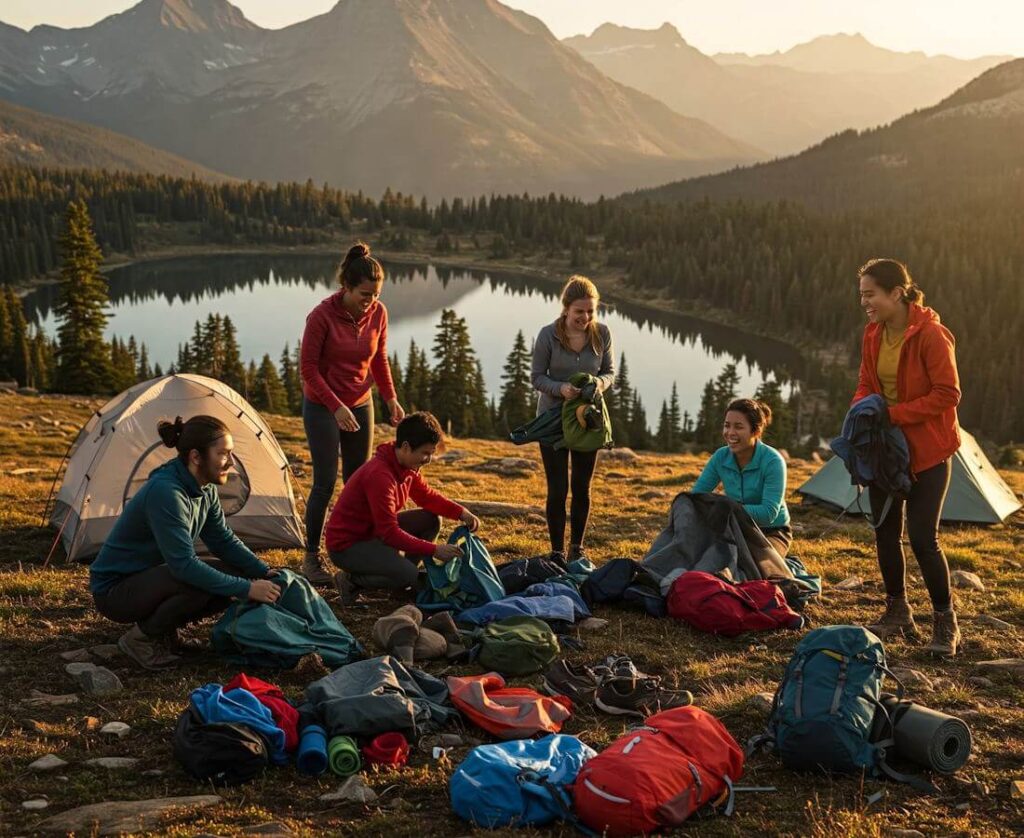Introduction to Hiking Essentials
Hiking is one of the most rewarding outdoor activities, offering an opportunity to connect with nature while engaging in physical exercise. However, embarking on a hiking trip requires careful consideration of the gear and equipment necessary for a safe and enjoyable experience. Hiking essentials refer to the vital items that ensure comfort, safety, and convenience during your adventures in the great outdoors. These items can range from footwear and clothing to specialized equipment like tents, backpacks, and navigation tools.
One effective approach to acquiring these essential items for hiking is through renting. Renting specialized hiking gear has gained popularity, as it provides several benefits that can enhance the overall experience. First and foremost, renting helps in reducing the overall costs associated with purchasing expensive hiking equipment. High-quality gear can be quite pricey, and for occasional hikers, investing in this equipment might not be practical. By choosing to rent, hikers can obtain the necessary items without a significant financial burden.
Additionally, renting gear ensures access to up-to-date and well-maintained equipment. Rental services often provide high-quality items that are regularly inspected and replaced, allowing outdoor enthusiasts to experience the latest technology and safety features in hiking gear. This access can significantly enhance the quality of a hiker’s experience and provide peace of mind, knowing that the equipment is reliable and efficient.
Another benefit of renting is the alleviation of the burden associated with packing and transporting heavy gear. Rentals allow hikers to travel light, focusing on enjoying the journey rather than struggling under the weight of cumbersome equipment. This convenience is especially important for those who may be traveling long distances to their hiking destination, making the overall trip more enjoyable and less stressful.
High-Quality Hiking Boots
When embarking on a hiking trip, having the right footwear is paramount to ensure a safe and enjoyable experience. High-quality hiking boots are specifically designed to offer the necessary comfort, support, and protection required for traversing various terrains. Renting high-quality hiking boots can be a cost-effective solution for those who may not hike frequently enough to justify purchasing a pair. Opting for rental allows hikers to access premium brands and models that can significantly enhance their outdoor experience.
When selecting hiking boots, it is crucial to consider several features that contribute to their functionality. First and foremost, the fit of the boots should be prioritized; a properly fitted boot will reduce the risk of blisters and foot fatigue. It’s advisable to try on boots in person or rent from a provider that offers a flexible return or exchange policy to accommodate any necessary adjustments. Additionally, look for boots that provide adequate ankle support, especially if planning to tackle rugged or uneven trails.
Another important aspect to assess is the boot’s waterproofing capabilities. Many reputable hiking boots come with built-in waterproof membranes that help keep feet dry in wet conditions, enhancing overall comfort. Traction is another feature that should not be overlooked; sturdy outsoles with aggressive tread patterns allow for better grip on slippery or rocky surfaces, ensuring stability during challenging hikes.
In summary, renting high-quality hiking boots can greatly influence the success of a hiking trip. By carefully considering the fit, support, waterproofing, and traction of potential rental options, hikers can make informed choices that will contribute significantly to their overall enjoyment and safety on the trail.
Lightweight Backpacking Tent
A lightweight backpacking tent is an indispensable item for anyone embarking on a multi-day hiking adventure. The necessity of having a reliable shelter cannot be overstated, as it provides protection from unpredictable weather conditions and the elements that nature may present. Renting a quality tent allows hikers to experience the great outdoors without the commitment of purchasing equipment that may only be used sporadically.
When choosing a tent for rent, it is crucial to consider several factors, including weight, size, and durability. Lightweight tents are specifically designed to minimize bulk and weight, making them easier to carry over long distances. A good rule of thumb is to prioritize a tent that weighs no more than two to three pounds per person. This ensures that the tent contributes minimally to the overall load while providing sufficient space for comfort.
In addition to weight, tent size matters significantly. While it may be tempting to opt for a smaller tent to save weight, it is important to ensure adequate space for sleeping and storing gear. A two-person tent, for instance, can comfortably accommodate two individuals along with their backpacks, whereas a three-person tent provides extra space for moving around or storing gear inside. Adequate ventilation and weather resistance are also key features to consider; look for tents with mesh panels and rainfly options to offer optimal protection against rain and insects.
Setting up a tent can be daunting for novice hikers, but with practice, it becomes a straightforward task. It is best to choose a flat spot free of rocks and debris and to use the provided stakes to secure the tent firmly. Familiarizing oneself with the tent setup process during daylight ensures a smoother experience, particularly at the end of a long day on the trails.
Portable Camping Stove
When embarking on a hiking trip, having the right cooking equipment is essential to ensure a comfortable and enjoyable experience in the great outdoors. One crucial item that often gets overlooked is a portable camping stove. Renting a portable camping stove can provide numerous benefits, primarily convenience and safety, allowing hikers to prepare meals with ease and reliability while in remote locations.
Portable camping stoves come in various designs and fuel types, including canister stoves, liquid fuel stoves, and wood-burning stoves, each catering to different needs. Canister stoves are known for their ease-of-use and quick setup, making them ideal for novice campers or those with limited time. In contrast, liquid fuel stoves offer versatility in cooking methods and can function reliably in colder conditions, which may be beneficial for hikers headed to higher elevations. Wood-burning stoves provide an authentic camping experience and can utilize natural resources, although they may require more effort in terms of fuel gathering.
In terms of meal preparation, portable camping stoves open the door to an array of culinary possibilities. Hikers can enjoy warm, satisfying meals that enhance their outdoor experience. Simple dishes such as soups, stews, pasta, and rice can be easily cooked on a camping stove. With a few well-chosen ingredients, hikers can also experiment with gourmet meals by creating stir-fries or even desserts like pancakes. Additionally, being able to boil water for beverages like coffee or tea can significantly uplift the morale during a hiking trip.
In conclusion, renting a portable camping stove is a prudent choice for any hiking trip. It not only provides convenience and safety but also contributes to a more fulfilling outdoor experience by allowing hikers to prepare comforting meals amidst their adventures.
4. High-Performance Sleeping Bag
A high-performance sleeping bag is not just a luxury; it is an essential item for anyone planning a hiking trip. Having a suitable sleeping bag can significantly enhance your outdoor experience, ensuring that you stay warm and comfortable throughout the night. When selecting a sleeping bag, it is crucial to consider factors such as insulation type, temperature rating, and the weather conditions expected during your trip.
There are primarily two types of insulation materials used in sleeping bags: down and synthetic. Down insulation is known for its lightweight and excellent compressibility, making it a popular choice among backpackers. However, it loses its insulating properties when wet, so it is essential to keep it dry. Synthetic insulation, on the other hand, continues to provide warmth even if it gets damp. This feature makes synthetic bags ideal for unpredictable weather conditions encountered in various hiking locations.
It is also important to choose a sleeping bag that is rated for the temperatures you expect to encounter. For instance, if you plan to camp in cooler weather, a sleeping bag with a lower temperature rating will help you maintain warmth, whereas warmer conditions may require a lighter bag. Renting a high-performance sleeping bag allows you to select the appropriate model for your specific hiking adventure without the financial commitment of purchasing one. Additionally, ensuring the sleeping bag is clean and well-maintained will enhance its effectiveness in keeping you warm. Many rental services offer sleeping bags that are regularly inspected and cleaned, providing an excellent option for hikers.
Ultimately, investing time into choosing the right sleeping bag can make a considerable difference in your hiking experience, providing you with the comfort and warmth necessary for a restful night in the great outdoors.
Navigation and Safety Gear
When embarking on a hiking trip, the importance of navigation and safety gear cannot be overstated. Having the right equipment on hand can ensure not only a more enjoyable experience but also your safety while traversing unfamiliar terrains. Among the essential items to consider renting are GPS devices, compasses, and detailed maps. These tools can provide critical information regarding your location and help you navigate effectively through various landscapes.
GPS devices have revolutionized the way hikers explore. They offer real-time location tracking, route navigation, and can even provide alerts for unforeseen hazards. Renting a GPS device ensures that you have access to the latest technology without making a significant investment. However, it is vital to familiarize yourself with the device’s functionalities prior to heading out, as reliance on technology requires a degree of understanding to use effectively.
In addition to GPS, a traditional compass remains an invaluable navigation tool. While digital devices are efficient, a compass does not rely on batteries or satellite signals, making it a reliable alternative in situations where technology fails. When renting a compass, take the time to learn how to read and utilize it alongside physical maps, which are recommended for simplicity and reliability.
Maps, whether topographic or digital, are crucial for understanding the terrain you will be hiking in. They provide context on elevation changes, trails, and landmarks that can aid in navigation. Having a physical map as a backup to electronic devices is essential, as it enhances overall safety.
Beyond navigation tools, safety gear such as first aid kits, whistle, and headlamps should be part of your rental list. These items contribute to your preparedness in emergency situations. Hikers are encouraged to plan their route, share their itinerary with someone, and remain aware of weather conditions, enhancing overall safety during their outdoor adventures.
Additional Rental Gear to Consider
When planning a hiking trip, certain rental gear can enhance your outdoor experience significantly. While essentials like tents, sleeping bags, and backpacks are crucial, additional items can provide greater comfort and efficiency on the trail. Trekking poles, for instance, are becoming increasingly popular among hikers for their ability to improve stability and reduce strain on the joints, particularly during steep ascents and descents. This equipment can be easily rented and can make a substantial difference in your overall hiking experience.
Another option worth considering is a hammock. Hammocks can offer a relaxing way to take a break during your trek or to set up camp in areas where flat ground may be limited. They are lightweight and easy to pack, making them a convenient addition to your gear. Renting a hammock allows you to test different models and find one that suits your preferences without investing in a purchase. Additionally, when paired with a rain tarp, a hammock can serve as a protective spot that shields you from unpredictable weather during your journey.
Hydration systems are also essential items to consider renting. Staying hydrated is vital during long hikes, and a hydration reservoir or a hydration backpack can provide easy access to water without the hassle of traditional bottles. Many of these systems come with integrated filtration options, offering the possibility to refill from natural water sources safely. This convenience encourages more frequent hydration, which is key to maintaining energy levels on the trail.
Incorporating these additional rental items into your hiking gear can significantly improve your comfort and enjoyment. By considering options like trekking poles, hammocks, and hydration systems, you can customize your hiking experience to meet your individual needs and preferences, ensuring a more enjoyable adventure in nature.
Where to Rent Hiking Gear
When planning a hiking trip, securing the proper gear is essential, but purchasing equipment can often be costly and impractical, especially for occasional hikers. Renting hiking gear is an excellent alternative that offers both convenience and cost savings. There are various avenues through which individuals can find reliable and appropriate rental options.
Local outdoor shops frequently provide rental services, and these establishments can be found in most areas with popular hiking trails. Visiting a nearby outdoor retailer allows hikers to inspect gear physically and receive personalized recommendations from knowledgeable staff. Additionally, these shops often carry a wide selection of items such as tents, backpacks, and hiking boots, catering to diverse needs.
For those preferring an online approach, several reputable rental services specialize in outdoor gear. Websites like REI Co-op’s rental program and Outdoors Geek offer users the ability to browse inventory, check availability, and even arrange home delivery. Renting online provides more flexibility and can often assure access to a broader range of high-quality equipment than local shops. However, it is important to review rental conditions carefully, including shipping fees, rental duration, and return policies, to avoid unexpected charges.
Additionally, checking customer reviews is critical when selecting a rental service. Specific platforms and social media groups dedicated to hiking enthusiasts can provide insights and recommendations based on personal experiences. Engaging with these communities can further enhance your knowledge about where to rent hiking gear. Prioritize companies that demonstrate strong customer satisfaction and transparency in their rental terms.
By exploring both local and online options and focusing on reliable reviews, hikers can ensure they rent the best gear suited for their outdoor adventures.
Preparing for Your Hiking Trip
Preparing for a hiking trip entails several important steps that contribute significantly to the overall experience on the trail. One of the fundamental aspects of preparation is planning the hiking route. Prior to setting out, familiarize yourself with the chosen trail, including its difficulty level, estimated time duration, and any specific challenges it may pose. Utilizing reliable maps or GPS navigation tools can ensure you stay on track and avoid unnecessary detours. Moreover, it is advisable to check for recent trail conditions and any pertinent alerts regarding weather forecasts or wildlife sightings that may influence your journey.
Packing effectively is yet another critical component of hiking preparation. A well-planned packing strategy ensures that you carry only essential items, which can minimize weight and enhance your hiking efficiency. Begin by creating a checklist of the necessary gear, including food, water, clothing layers, and safety equipment such as a map and a first aid kit. If renting equipment, opt for high-quality items suited for your specific hiking conditions. Additionally, distributing weight evenly in your backpack will contribute to comfort during the hike. Focus on incorporating versatile items, such as clothing that can adapt to varying temperatures and conditions.
Testing rental gear before embarking on your hiking trip is essential to ensure functionality and comfort. Take the time to familiarize yourself with any rented equipment, such as hiking poles or tents. Performing short test hikes can help you assess how well the gear performs and if any adjustments are needed to improve usability. This practice not only guarantees that your gear is reliable but also builds confidence in your setup. By following these preparation strategies, participants can embark on their hiking trip fully equipped and prepared, making the adventure more enjoyable and fulfilling.
Conclusion: Make the Most of Your Hiking Rental Experience
In reflecting upon the vital essentials for your upcoming hiking expedition, it is evident that renting can offer remarkable advantages to enhance your journey. By opting for rental gear, you not only reduce costs associated with purchasing expensive equipment but also gain access to high-quality, specialized items well-crafted for outdoor adventures. Importantly, this option allows you to test various equipment types and brands without the long-term commitment, which can be particularly beneficial for novice hikers or those planning a one-off adventure.
Throughout this blog post, we have discussed five essential items that significantly contribute to a successful hiking trip. These include high-performance tents, versatile backpacks, durable sleeping bags, reliable footwear, and quality trekking poles. Each of these components plays a crucial role in ensuring safety, comfort, and enjoyment on the trails. The right gear can mean the difference between a memorable experience and a challenging one.
Moreover, renting enhances sustainability within the hiking community by promoting shared resource usage. As more adventurers discover the benefits of rental options, the overall impact on natural resources can be minimized. This collective approach fosters a responsible attitude toward outdoor activities, encouraging others to engage in environmentally considerate practices.
We encourage you to share your hiking experiences and rental insights within the community, as your contributions not only enrich the collective knowledge but also help fellow enthusiasts make informed decisions. Renowned hiking adventures await you, and by selecting the right rental equipment, you can embark on your next journey with confidence. Experience the great outdoors while ensuring you make the most of your hiking rental experience.




